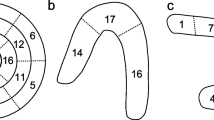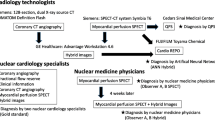Abstract
Purpose
We have recently presented a decision support system for interpreting myocardial perfusion scintigraphy (MPS). In this study, we wanted to evaluate the system in a separate hospital from where it was trained and to compare it with a quantification software package.
Methods
A completely automated method based on neural networks was trained for the interpretation of MPS regarding myocardial ischaemia and infarction using 418 MPS from one hospital. Features from each examination describing rest and stress perfusion, regional and global function were used as inputs to different neural networks. After the training session, the system was evaluated using 532 MPS from another hospital. The test images were also processed with the quantification software package Emory Cardiac Toolbox (ECTb). The images were interpreted by experienced clinicians at both the training and the test hospital, regarding the presence or absence of myocardial ischaemia and/or infarction and these interpretations were used as gold standard.
Results
The neural network showed a sensitivity of 90% and a specificity of 85% for myocardial ischaemia. The specificity for the ECTb was 46% (p < 0.001), measured at the same sensitivity. The neural network sensitivity for myocardial infarction was 89% and the specificity 96%. The corresponding specificity for the ECTb was 54% (p < 0.001).
Conclusion
A decision support system based on neural networks presents interpretations more similar to experienced clinicians compared to a conventional automated quantification software package. This study shows the feasibility of disseminating the expertise of experienced clinicians to less experienced physicians by the use of neural networks.
Similar content being viewed by others
References
Hachamovitch R, Berman DS, Shaw LJ, Kiat H, Cohen I, Cabico JA, et al. Incremental prognostic value of myocardial perfusion single photon emission computed tomography for the prediction of cardiac death: differential stratification for risk of cardiac death and myocardial infarction. Circulation. 1998;97:535–43. Erratum in: Circulation 1998;98:190.
Kang X, Berman DS, Van Train KS, Amanullah AM, Areeda J, Friedman JD, et al. Clinical validation of automatic quantitative defect size in rest technetium-99m-sestamibi myocardial perfusion SPECT. J Nucl Med. 1997;38:1441–6.
Berman DS, Kang X, Van Train KF, Lewin HC, Cohen I, Areeda J, et al. Comparative prognostic value of automatic quantitative analysis versus semiquantitative visual analysis of exercise myocardial perfusion single-photon emission computed tomography. J Am Coll Cardiol. 1998;32:1987–95.
Lindahl D, Lanke J, Lundin A, Palmer J, Edenbrandt L. Improved classifications of myocardial bull’s-eye scintigrams with computer-based decision support system. J Nucl Med. 1999;40:96–101.
Gjertsson P, Lomsky M, Richter J, Ohlsson M, Tout DA, Van Aswegen A, et al. The added value of ECG-gating for the diagnosis of myocardial infarction using myocardial perfusion scintigraphy and artificial neural networks. Clin Physiol Funct Imaging. 2006;26(5):301–4. Sep.
Germano G, Kiat H, Kavanagh PB, Moriel M, Mazzanti M, Su HT, et al. Automatic quantification of ejection fraction from gated myocardial perfusion SPECT. J Nucl Med. 1995;36:2138–47.
Sharir T, Germano G, Waechter P, Kavanagh PB, Areeda JS, Gerlach J, et al. A new algorithm for the quantitation of myocardial perfusion SPECT. I. Validation and diagnostic yield. J Nucl Med. 2000;41:720–7.
Van Train KF, Areeda J, Garcia EV, Cooke CD, Maddahi J, Kiat H, et al. Quantitative same-day rest-stress technetium-99m-sestamibi SPECT: definition and validation of stress normal limits and criteria for abnormality. J Nucl Med. 1993;34:1494–502.
Lomsky M, Richter J, Johansson L, El-Ali H, Åström K, Ljungberg M, et al. A new automated method for analysis of gated-SPECT images based on a 3-dimensional heart shaped model. Clin Physiol Funct Imaging. 2005;25:234–40.
Lomsky M, Richter J, Johansson L, Høilund-Carlsen PF, Edenbrandt L. Validation of a new automated method for analysis of gated-SPECT images. Clin Physiol Funct Imaging. 2006;26:139–45.
Rumelhart DE, McClelland JL, eds. Parallel distributed processing, vols. 1 and 2. Cambridge: MIT Press; 1986.
Rögnvaldsson T. On Langevin updating in multiplayer perceptrons. Neural Comput. 1994;6:916–26.
Hanson SJ, Pratt LY. Comparing biases for minimal network construction with backpropagation. In: Touretzky DS, editor. Advances in neural information processing systems. San Mateo: Morgan Kaufmann; 1998. p. 177–85.
Van Train KF, Garcia EV, Maddahi J, Areeda J, Cooke CD, Kiat H, et al. Multicenter trial validation for quantitative analysis of same-day rest-stress technetium-99m-sestamibi myocardial tomograms. J Nucl Med. 1994;35:609–18.
Riffenburgh RH. Statistics in medicine. London: Academic; 1999.
Lindahl D, Toft J, Hesse B, Palmer J, Ali S, Lundin A, et al. Scandinavian test of artificial neural network for classification of myocardial perfusion images. Clin Physiol. 2000;20:253–61.
Heden B, Ohlin H, Rittner R, Edenbrandt L. Acute myocardial infarction detected in the 12-lead ECG by artificial neural networks. Circulation. 1997;96:1798–802.
Acknowledgements
This study was supported by grants from the Gothenburg Medical Society, Gothenburg, Sweden and the Sahlgrenska University Hospital, Gothenburg, Sweden.
Conflict of interest
Lars Edenbrandt, Jens Richter and Mattias Ohlsson are shareholders in Exini Diagnostics AB, which owns a neural-network-based decision support system for analysis of myocardial perfusion images.
Author information
Authors and Affiliations
Corresponding author
Additional information
This study was supported by grants from the Gothenburg Medical Society, Gothenburg, and the Sahlgrenska University Hospital, Gothenburg, Sweden.
Rights and permissions
About this article
Cite this article
Lomsky, M., Gjertsson, P., Johansson, L. et al. Evaluation of a decision support system for interpretation of myocardial perfusion gated SPECT. Eur J Nucl Med Mol Imaging 35, 1523–1529 (2008). https://doi.org/10.1007/s00259-008-0746-9
Received:
Accepted:
Published:
Issue Date:
DOI: https://doi.org/10.1007/s00259-008-0746-9




